On the southern edge of the Brazilian Amazon rainforest, construction is underway. Using wood confiscated from illegal logging, scientists are building a platform beneath the trees that will limit the rainwater reaching their roots. The experiment, covering 10,000 square metres, will monitor how long the trees survive under extreme drought conditions. The aim is to more closely pinpoint the ‘tipping point’ at which reduced rainfall will see trees in this vulnerable part of the Amazon dying on a large scale.
The Amazon rainforest plays a unique role in the Earth’s ecosystem. Covering an area of 5.5 million square kilometres, the Amazon’s forests are the most biodiverse on the planet, absorb up to a tenth of the world’s CO₂ emissions, and sustain rainfall at a continental scale. However, they are under increasing threat from deforestation and climate change. Increasing droughts are having a major impact, changing the make-up of the forests as trees begin to die. Understanding the physiological changes in the trees that are caused by drought and the thresholds at which the trees can no longer survive will help scientists identify how best to protect these vital forests in the face of a changing climate.
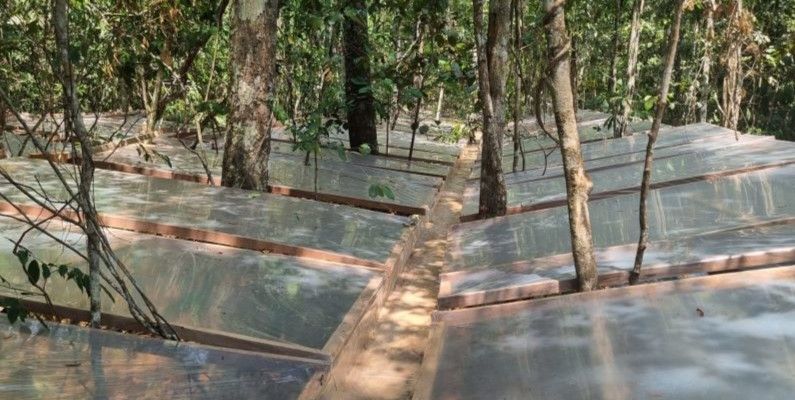
Caption: Finalised rainfall exclusion experimental structure. Credits: Antonio Carlos Lola da Costa.
Similar experiments have been built before in the north-east of the Amazon, but the location this time, in the state of Mato Grosso, is of particular importance, according to lead researcher David Galbraith, Professor of Terrestrial Ecosystem Science at the University of Leeds’ School of Geography.
“Previous rainfall exclusion projects have been in relatively ‘safe’ areas of the Amazon, where the trees don’t regularly experience water stress, even during the dry season,” says Professor Galbraith. “Our project will take place in the southern part of the Amazon, which is on the front line of the battle with climate change. This area is already the driest and warmest part of the Amazon and is now where you see the most pronounced changes, with temperatures rising fast and the number of dry days increasing. It’s the place where the tipping point for the rainforest is most likely to be first reached.”
Professor Galbraith is working with scientists from the Mato Grosso State University (UNEMAT), the Federal University of Pará and the Amazon Environmental Research Institute (IPAM) on the project, called Lethal Ψ. The Greek letter Ψ (or Psi) is used to denote the tension with which water is held in plant tissues – under drought, this tension becomes more severe. The project aims to assess at what point the trees’ ability to transport water from root to canopy becomes fatally impaired.
Professor Beatriz Schwantes Marimon from UNEMAT, one of the key researchers on the project, says: “In addition to scientific information on the resistance and resilience of the forest in the southern Amazon and how these forests might respond to different future scenarios, a great merit of this project will be to contribute to the training of young scientists in the Amazon. Increasing the skills of these young scientists will allow them to become protagonists of ecological research in the Amazon in the near future. In this way, they will also be able to propose public policies for the sustainable use and conservation of the largest tropical forest on the planet, and improve the living conditions of local people.”
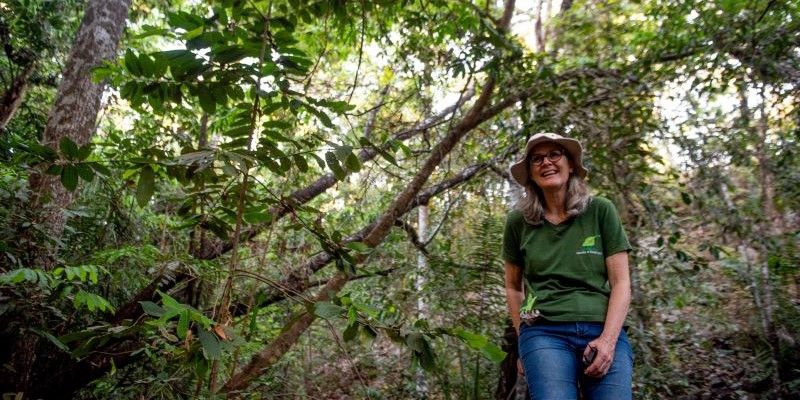
Caption: Professor Beatriz Schwantes Marimon (Universidade do Estado de Mato Grosso - UNEMAT). Credits: Jacqueline Lisboa/WWF Brasil.
The experimental site is being constructed at the Tanguro Research Station, run by project partners IPAM, on a privately-owned forest area located on a large 96,000-hectare ranch in the municipality of Querência, Mato Grosso state. The experimental site is one of the Amazon’s southernmost forests, only about 30 kilometres away from the boundary between the forest and the savannah. Two plots of one hectare in size have been carefully chosen for the new rainfall exclusion project to include a representative range of trees. One will see half of any rainfall diverted away from the trees, while the other – which has similar trees in terms of age and species – will be left to act as a control site.
IPAM researcher and General Coordinator of the Tanguro Research Station, Leonardo Maracahipes-Santos also stresses the importance of the new experiment’s location:
“The forest in and around the Tanguro Research Station has unique characteristics,” he explains. “There has been a lot of expansion and intensification of agriculture in the region in recent decades. It’s important and very timely to understand how these forests, which are already under pressure, will respond to increasing drought.”
Although construction of the rainfall exclusion platform has only now been finalised, the research has been underway for about one year, gathering baseline data. All the trees whose trunks are over 10 centimetres in diameter have been tagged and measured, with solar powered sensors put in place to take continuous measurements of soil moisture and water transport in trees. Repeated measurements are also made to understand the impacts of drought on forest carbon balance; these include measurements of photosynthesis, tree growth and tree mortality.
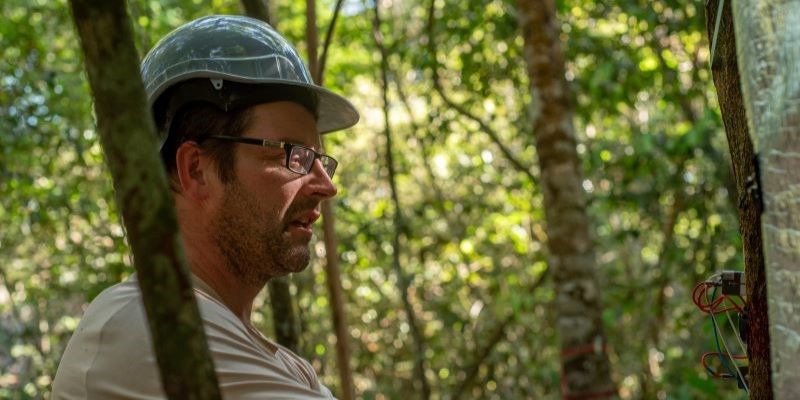
Caption: David Galbraith verifying the installation of sap flow sensors. Credits: Jacqueline Lisboa/WWF Brasil.
Monthly drone flights will be carried out over each site to measure leaf temperatures, the greenness of the canopy, and monitor changes in canopy structure. The trees will be regularly measured, and the drone and sensor data will be analysed to assess the ability of the plants to transport water under stress. The site will be monitored to see how many trees succumb to the drought conditions and die.
A team of four staff will be permanently on-site, responsible for carrying out core data collection on a daily, weekly and monthly basis. A large number of postgraduate students at UNEMAT are collecting data at the experimental site to directly underpin their PhD projects, each with a specific project to investigate aspects of how drought affects the functioning of tropical trees.
Carla Heloísa Luz de Oliveira is one of the researchers working at the site to gather this baseline data on the Lethal Ψ project. She recently completed a Masters degree at UNEMAT, supervised by Professor Schwantes Marimon and Professor Galbraith, who is also a visiting lecturer there.
“We’re digging two pits on each plot, six metres deep,” Carla explains. “We’ll fit sensors every half a metre down into the pit, to measure soil moisture at different depths. We’ll be able to compare soil moisture in the period before the rainfall was restricted with similar measurements once that restriction begins. And of course, we’ll be comparing the impact of the restricted rainfall on the experimental site with data from the control site where there’s no restriction.”
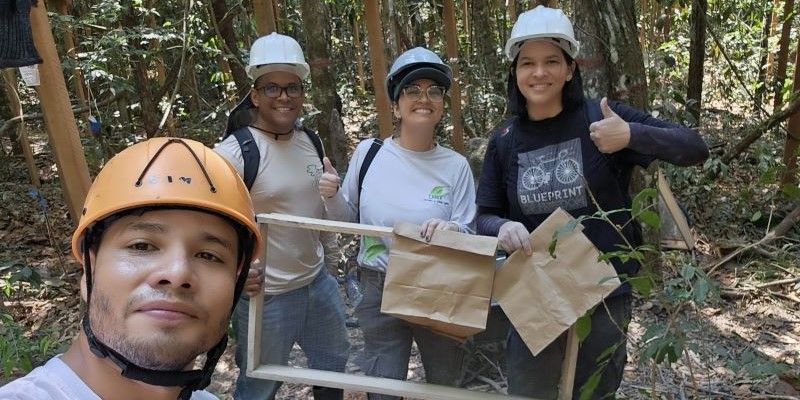
Caption: Carlos Dias, Eder Carvalho, Melina Arantes and Carla Luz following quantification of root biomass in the study plots. Credits: Carlos Dias.
Partnerships between all the institutions involved is key to the success of the project, according to Professor Galbraith.
“All of this research is only really possible through a strong and dynamic collaboration with our partners in Brazil,” he says. “We’ve worked with Professor Beatriz Schwantes Marimon and Professor Ben Hur Marimon Junior from UNEMAT for many years, and they’ve been instrumental in helping us set up the sites, with students and early career researchers from the university active at the site to gather data. Professor Antonio Carlos Lola da Costa, from the Federal University of Pará (UFPA) has overseen the construction of the experiment on the ground. This has been a massive effort and has involved supervising a team of ten people for a period of four months to build the experimental infrastructure. And of course, the site itself at the Tanguro Research Station has been made available by IPAM, with their scientists working with us to analyse the data generated.”
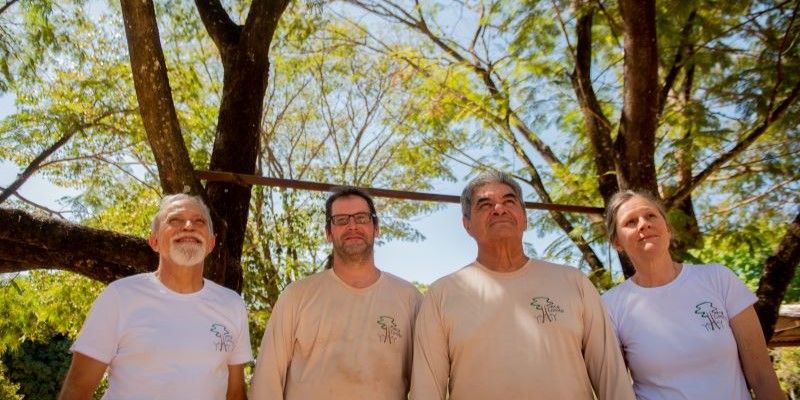
Caption: The Project Coordination Team: Prof. Ben Hur Marimon Junior (UNEMAT), Prof. David Galbraith (University of Leeds), Prof. Antonio Carlos Lola da Costa (UFPA), Prof. Beatriz Schwantes Marimon (UNEMAT. Credits: Jacqueline Lisboa/WWF Brasil.
The project is funded for three years through the Natural Environment Research Council (part of UK Research and Innovation) but the team hope, once the construction of the experimental site is completed, that they will be able to source funding to keep gathering data for much longer.
Although trees in this part of the Amazon are more adapted to drought than those further north, the team expect some of the trees will die within the first three years of the experiment.
Professor Galbraith said: “These trees are already at their limit, with the climate already very dry, and the drought will force them beyond the limits of their current climate space. These trees in the southern Amazon face a particularly high risk of mortality, compared with trees in other regions of the Amazon. This will be the first time we can link changes in the trees’ hydraulic status (their ability to transport water)with their risk of death, to better understand what the point of no return for the trees of the Amazon is.”